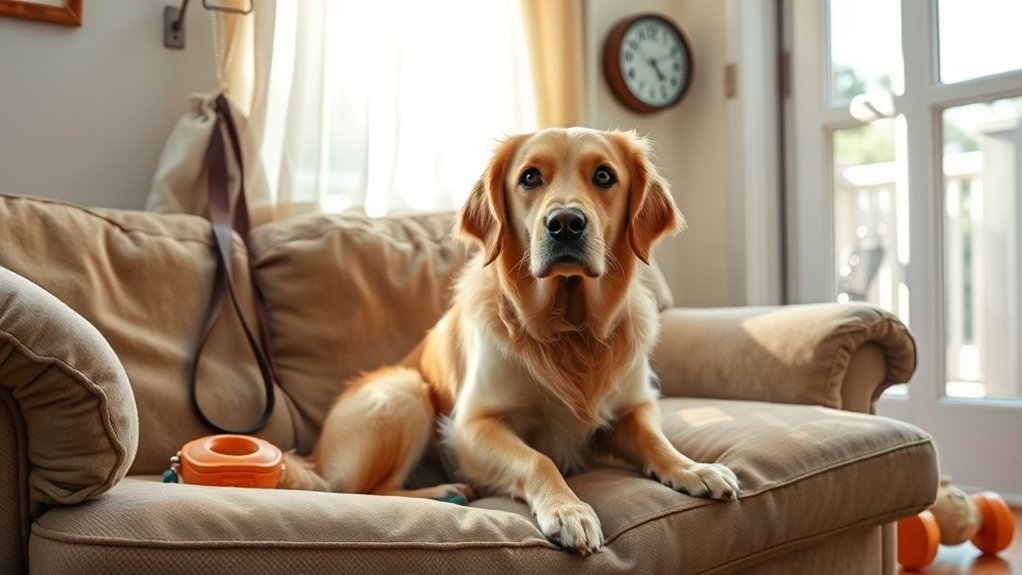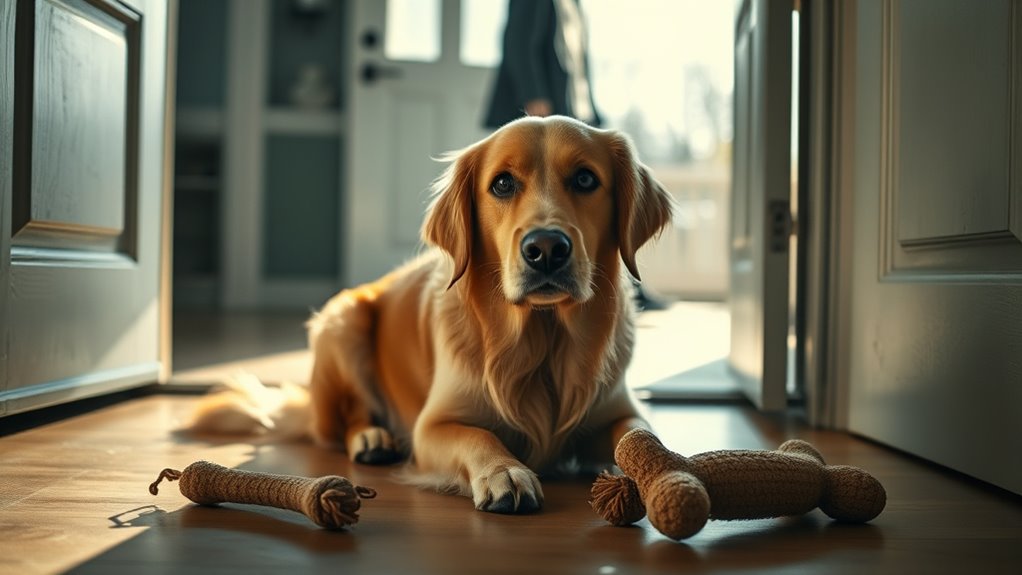Dog separation anxiety in dogs often stems from inadequate socialization and confidence issues. To help your pup cope, start with crate training, creating a safe space they associate with positive experiences. Gradually practice short departures to build their tolerance, staying calm during goodbyes. Make certain regular physical exercise and offer mental stimulation through puzzle toys. By addressing these factors, you can ease their anxiety. Discover more effective strategies to support your dog’s emotional well-being.
Key Takeaways
- Separation anxiety often stems from inadequate socialization and exposure during critical development stages in puppies.
- Proper socialization reduces stress and builds confidence, preventing the onset of separation anxiety in dogs.
- Crate training can help create a safe space, making dogs feel secure when left alone.
- Gradual practice with short departures helps dogs learn that being alone is temporary and manageable.
- Regular physical exercise and mental stimulation are vital for reducing anxiety and promoting overall well-being in dogs.

Have you ever come home to find your dog waiting by the door, only to witness their frantic attempts to greet you? Their wagging tail, excited barks, and desperate jumps can be heartwarming, but for some dogs, this enthusiasm masks deeper issues like separation anxiety. This condition can lead to destructive behavior, excessive barking, and overall stress for both you and your furry friend. Understanding the causes and implementing coping strategies can help ease their anxiety.
One crucial cause of separation anxiety is inadequate puppy socialization. If your dog hasn’t been exposed to different environments, people, and other animals during their critical development stages, they may struggle to feel secure when left alone. It’s vital to expose your puppy to various experiences in a positive way. Gradually introducing them to new situations helps build their confidence and reduces anxiety when you leave. Remember, the more comfortable they become with being around different stimuli, the better they’ll handle your absence. Furthermore, many experts recommend effective crate training as a way to create a safe environment for your dog.
Inadequate puppy socialization can lead to separation anxiety; exposing them to new experiences builds confidence and eases their stress.
Another key factor in addressing separation anxiety is using effective crate training techniques. A crate can provide a safe space for your dog, acting like their personal den. When introducing the crate, make it a positive experience. Place treats, toys, and comfortable bedding inside to encourage them to explore. Start by leaving the door open and gradually increasing the time they spend inside while you’re home. This way, they’ll associate the crate with comfort and security. Once they feel at ease, you can begin closing the door for short periods while you’re nearby, eventually progressing to longer absences.
You might also consider practicing short departures. Leave your dog alone for just a few minutes and gradually increase the time you’re away. This helps them learn that you will always return, easing their anxiety. Additionally, maintaining a calm and confident demeanor when you leave and return home can profoundly influence your dog’s behavior. Avoid making a fuss during goodbyes and reunions to minimize their emotional response.
Lastly, ensure your dog gets enough physical and mental stimulation. Regular exercise and engaging activities can tire them out and reduce anxiety levels. Puzzle toys or interactive games can keep their mind occupied, making it easier for them to cope while you’re away. By addressing these factors with understanding and patience, you’ll help your dog manage their separation anxiety, leading to a happier, more relaxed companion.
Frequently Asked Questions
Can Separation Anxiety Occur in Puppies Only?
Separation anxiety can occur in dogs of all ages, not just puppies. However, during puppy development, early training plays a vital role in shaping their behavior. If you expose your puppy to short separations and reward calmness, you can help prevent future anxiety. It is important to socialize and train them early to build their confidence. By fostering independence, you can reduce the likelihood of separation anxiety as they grow into adulthood.
Are Certain Dog Breeds More Prone to Separation Anxiety?
Absolutely, certain dog breeds seem to wear their hearts on their sleeves when it comes to separation anxiety! Breeds like Border Collies and Dachshunds often exhibit strong breed tendencies and genetic predispositions to this condition. When you leave them, it’s as if they’re throwing a dramatic farewell party! Knowing this can help you prepare and provide the right support for your furry friend, ensuring they feel secure even when you’re not around.
How Long Does Separation Anxiety Typically Last?
Separation anxiety can vary in duration, but it typically lasts as long as your dog feels uncomfortable alone. For some, the anxiety duration might be brief, resolving within a few weeks with proper training. Others may struggle for months or even longer without consistent support. Establishing a duration timeline for gradual desensitization can help. Be patient and encourage your dog, as each pup’s journey to feeling secure can differ markedly.
Can Medication Help With My Dog’s Separation Anxiety?
Yes, medication can help with your dog’s separation anxiety. Have you ever wondered how a little support could change their behavior? Medication options, like anti-anxiety drugs, might provide relief, especially when combined with behavioral therapies. These therapies teach your dog coping skills, making them more comfortable when you’re away. It is crucial to consult your vet to find the right approach tailored to your dog’s specific needs. Together, you can create a happier, more relaxed pup.
What Are the Signs My Dog Is Anxious When I Leave?
When you leave, your dog’s anxious signs may include excessive barking, whining, or howling. You might notice destructive behavior, like chewing furniture or scratching doors. Some dogs pace or try to escape, while others may exhibit signs of distress, like drooling or excessive panting. Using positive training techniques can help your dog feel more secure during your absence. Observing these behaviors closely can guide you in addressing their anxiety effectively.
Conclusion
Just like a child longing for their parent’s embrace, your dog feels the weight of your absence. By understanding the roots of their anxiety and employing coping strategies, you become the lighthouse guiding them through the storm. Remember, patience and love are your greatest tools. As you help them navigate their fears, you’ll both discover the joy of reunions, turning separation into a mere chapter in your shared story, not the whole book.










